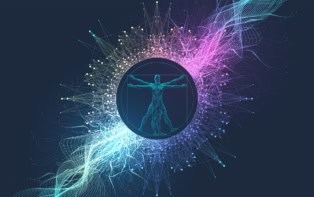
Researchers in the US have shown that the presence of spin-polarized electrons can make a chemical reaction involving “right-handed” molecules occur faster than the same reaction involving “left-handed” molecules. The discovery could help scientists understand why nature favours a certain handedness in many biological molecules.
An important question facing those trying to understand the origins of life is why important biological molecules have a certain handedness or “chirality”? Amino acids, for example, can be either right- or left-handed mirror-images of each other. However, they are always left handed when produced by living organisms. This is important because chirality can affect how a molecule takes part in the chemical reactions crucial for life.
Scientists believe that two external agents could be responsible for chirality in biological molecules: circularly polarized light and spin-polarized electrons.
Life from outer space?
While circularly polarized light is rare on Earth, astronomers know that it can be produced in the interstellar medium — leading some to speculate that the precursors to chiral biological molecules were created in space and somehow transported to Earth.
Low-energy spin-polarized electrons are produced when X-rays and other ionizing radiation strike iron, nickel and other magnetic materials. These materials are relatively abundant and such interactions could have occurred on the early Earth, on other planets and even in space.
Now, Richard Rosenberg and colleagues at the Argonne National Laboratory in Illinois and the Ames Laboratory in Iowa have shown that such electrons can affect the rate at which chiral molecules participate in a chemical reaction (Phys. Rev. Lett. 101 178301).
Magnetic surface
The team began with an ultra-clean sample of Permalloy — a magnetic iron-nickel alloy — held in ultra-high vacuum conditions. The Permalloy surface was covered with an ultrathin layer of 2-butanol, which is a relatively simple organic molecule that can occur in either right or left-handed versions. X-rays were fired at the surface, which causes some of the butanol molecules to react by either dissociation or breaking free. The team measured the amount of intact butanol remaining on the surface as a function of X-ray exposure time.
Physicists know that the rate at which such molecules react is affected by their interaction with the secondary electrons that are produced when the X-rays strike the substrate. If the Permalloy is magnetized, these secondary electrons became spin polarized — offering the team an opportunity to study the effect of spin-polarized electrons on chiral molecules.
To do this, the team first covered the Permalloy with three molecular layers of right-handed butanol. A magnetic field was applied along the surface to magnetize the Permalloy in one direction and then that rate at which the butanol molecules react was measured.
This entire process was then repeated with the Permalloy magnetized in the opposite direction — which meant that the secondary electrons were polarized in the opposite direction.
10% difference in reaction rates
After some careful analysis, the team were able to conclude that there was a 10% difference in the rate at which right-handed butanol reacted, depending on the polarization of the secondary electrons. The team then repeated the experiment using left-handed butanol and found the same 10% difference.
Remarkably, they found that electrons polarized in the “+” direction enhanced the reaction rate of right-handed butanol, while electrons polarized in the opposite “-” direction enhanced the reaction rate of left-handed butanol.
The reaction rate is a measure of the relative propensity for the butanol to dissociate or leave the surface — and Rosenberg’s experiment shows that for chiral molecules, the rate can be affected by the spin-polarization of the secondary electrons. In other words, they have shown that a chemical reaction involving chiral molecules can proceed differently in the presence of spin-polarized electrons.
The team is now planning to repeat their experiments using alanine, an amino acid that comes in right and left-handed versions.
While Rosenberg did not measure the spin-polarization of the secondary electrons, measurements by other physicists suggest that it is about 10%. The team is now working on measuring the polarization from its Permalloy sample and is also interested in repeating their experiments using substrates that emit secondary electrons with polarizations as high as 70%.




